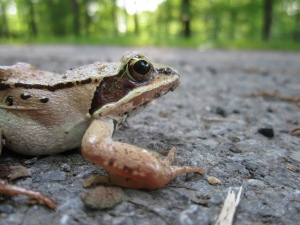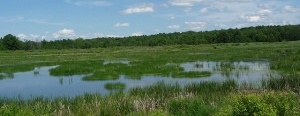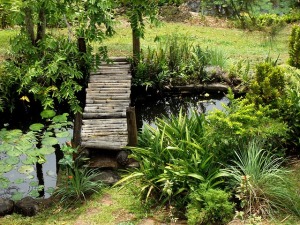
Frog crossing a road. Photo: Ezra Wolfe
I had a request from one of my readers who were concerned about the frogs getting killed by traffic. He wanted me to write about frogs and what we can do to help them. And since frogs as you already know is close to my heart I would love to tell you their story.
Frogs have an amazing life-cycle which begins in fresh water and continues on land. They are bound to breed in fresh water where they lay their eggs often on submerged plant parts. The tadpoles hatch and grow in a very special way, amphibian style. At first they got a tail and swims around in the pond. While growing they develop legs and prepares for a life on land. As a child I loved to watch the tadpoles and sometimes we caught them in a bucket just to look at them. We were cautious and always put them back in their pond. It is amazing to follow their growth and life-cycle as a kid it was like a miracle.
Threats and vulnerability
The most vulnerable part of the frogs life is breeding. Since they depend on fresh water which can be scarce to find. Pollution, traffic, changes in the landscape, agriculture (leak of nutrients and ditching) and human interference are some of the dangers. Frogs generally need quite ground ponds without fish and crayfish which prey on the eggs and tadpoles. The slopes into the pond should be gentle no steep edges making it hard for the frogs to get in and out of the water. There have to be some kind of vegetation on which the frogs can lay their eggs in protection from predators. The water have to be clean and have a pH near natural (pH 6-7). The frogs themself withstand a lower more acidic pH but the insects they eat often doesn´t. This is a typical scenario in nature which demands biologist and environmentalist to look at the whole ecosystem and count both primary and secondary threats. So now we have pointed out the most common threats. What can we do to help the frogs?
Protect wetlands
If we want to have frogs we have to protect the wetlands where they breed. Ditching out wetlands and filling them out is a huge threat. When planning new constructions these sensible habitats should be taken into account and optimally be saved.

Hunneyman Road Wetland Restoration Photo: U.S. Fish and Wildlife Service – Midwest Region
Build a garden pond
As an animal and garden person I can really recommend to build a garden pond to invite wildlife. Not only frogs will find your paradise but also newts and other water thriving animals. Of course you leave out the fish which makes it easier to keep the pond clean apart from keeping the frogs alive. You will find out that there is a number of beautiful plants suitable for the pond and the edges around it. In winter frogs need shelter under rocks or leaf piles preferably protected in hedges. So do not be to neat and tidy in the garden. If you have room for a larger pond you can build a deeper area in the center which doesn´t bottom freeze so the frogs can burrow down in the mud to hibernate. As a bonus you get a natural pest control since frogs prey on insects.
Construct wildlife refuges and passages in the infrastructure
This is something many communities try to work with. In Sweden we have the The Swedish Society for Nature Conservation. Frogs have to migrate during their breeding season (occurs during the Spring in Sweden) to find fresh water to spawn in. This means they have to take on a sometimes dangerous trip over large areas. Crossing a heavy trafficked road or dry land without vegetation may be equal to death. In some places tunnels are digged under the roads to create safe passages for frogs. In high (frog) populated areas people sometimes get together and move the frogs by hand to keep them safe.
Minimize pollution and leakage of nutrients
And finally we have to minimize pollution both directly into water resources and secondary as acidic rain. Agriculture is a main cause of leakage of nutrients into the ecosystems. A more restrained use of nutrients and pesticides is of need. The large-scale agriculture is demanding great areas and often involves ditching or draining wetlands which you now know is a killer for aquatic and semi-aquatic animals.
Want to read more about wildlife gardens?
- Wildlife garden – Wikipedia
- National Wildlife Federation
- The Wildlife Trusts
-
The Wildlife Garden in Spring by Jenny Steel – e-book




Such a good pay, filed with so much information I never knew about frogs! I’m happy to have jabbed something new about a subject I would have not looked up on my own.
By the way, Baby Boy had fun seeing me read this post, going “frog frog….” endlessly lol 🙂
LikeLike
How cute he is – Baby Boy 🙂 He likes frogs that is a good start!
Thank you for your comment. I am glad that I can inspire and share some of my little knowledge 🙂
LikeLiked by 1 person
Love this! I love frogs, I have a special place in my heart for them.. and turtles! Anyhoo, great post my friend. ❤ – http://www.domesticgeekgirl.com
LikeLiked by 1 person
Thank you ❤ Turtles are adorable too. But I stop there otherwise I could go on with listing every cute animal there is lol
LikeLike
Exceptional article. Thank you. How can I share it on my own google plus site?
“If we want to have frogs we have to protect the wetlands where they breed. Ditching out wetlands and filling them out is a huge threat. When planning new constructions these sensible habitats should be taken into account and optimally be saved.”
What the crap, my county just upgraded a highway that has if anything a decreasing traffic flow. Part of the construction involved destroying the wetlands it goes through. As a private person I could never have done this … but govt. YUP, always and DOE was involved. Go figure WHERE are we are going to get protection for our wildlife.
LikeLike
Thank you!
I know – this is a constant and on-going problem. When money talks nature is almost always left unheard. It breaks my heart everytime I read about this awful acts of man-kind. But we should not forget the success stories. Wetlands are restored and people join up for a cause of action. Thank you for your comment, Herb.
If you want to share my post you can copy my url https://mygreennook.wordpress.com/2015/01/30/a-frogs-life/ and post it like a link on g+. Otherwise you can share my g+ post direct on g+ and add a comment.
Have a great weekend!
LikeLike
thanks Charlotte,
I figured it out and have had a great response … as well as one strange comment.
LikeLike